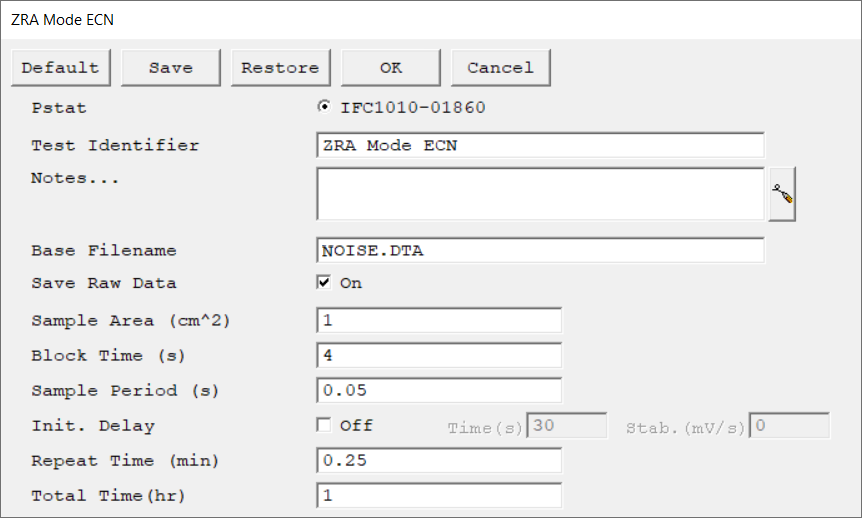Description
Parameter |
Description |
Units |
||
|---|---|---|---|---|
Select the potentiostat/galvanostat to perform the experiment. Each radio button corresponds to an installed potentiostat. You can select only one potentiostat at a time. Potentiostats that are already in use are marked with an asterisk. They can be selected but cannot be used. |
|
|||
A string that is used as a name. It is written to the data file, so it can be used to identify the data in database or data manipulation programs. The Identifier string defaults to a name derived from the technique's name. While this makes an acceptable curve label, it does not generate a unique descriptive label for a data set. The Identifier string is limited to 80 characters. It can include almost any normally printable character. Numbers, upper- and lower-case letters, and the most common punctuation characters including spaces are valid. |
|
|||
Enter several lines of text that describe the experiment. A typical use of Notes is to record the experimental conditions for a data set.
Notes defaults to an empty string and is limited to 400 characters. It can include all printable characters including numbers, upper- and lower-case letters, and the most common punctuation including spaces. Tab characters are not allowed in the Notes string. Press the Notes button on the right-hand side to open a separate Notes dialog box. |
|
|||
The name of the file in which the output data are written. By default, it is saved in the default file directory.
|
|
|||
If enabled, raw data files are saved during an electrochemical noise experiment. The files are saved to a subfolder of the current data folder. The subfolder is automatically given the base name that you choose, with a default of NOISE. The file names of the raw data files consist of the base name, followed by the burst number. For example, NOISE21.DTA contains data recorded during the 21st step. |
|
|||
The surface area of the sample that is exposed to the solution. The software uses the sample area to calculate the current density and corrosion rate (if applicable). If you do not want to enter an area, we recommend that you leave it at the default value of 1.00 cm².
|
cm2 |
|||
The length of time in which data are acquired for each block. Each block of data is later reduced to a single data point. The allowed range for the Block Time parameter is controlled by the Sample Period parameter which is discussed in the Sample Period section. |
seconds (s) |
|||
The time between data points within a data block. The minimum value that we recommend with the unmodified scripts is 0.1 s. The longest Sample Period allowed is 600 s.
|
seconds (s) |
|||
Use the Initial Delay parameter to tell the system your definition of a stable potential and when to begin the actual measurement. If the absolute value of the Eoc drift-rate falls below the Stability parameter, the Initial Delay phase ends immediately and the experiment begins, disregarding the Time parameter. The drift rate can never fall below zero, so entering a Stability value of zero ensures that the Initial Delay will not end prematurely. A typical value is 0.05 mV/s. The lower limit of the Stability parameter is set by your patience. For example, a stability of 0.01 mV/s indicates a drift of less than 1 mV within 100 seconds. |
seconds (s), mV/s |
|||
The time between each test on the cell. |
minutes (min) |
|||
The duration of the experimental run. The script keeps track of the elapsed time from the start of the experiment. At the start of each test, the elapsed time is compared to the Total Time. If the elapsed time is greater than or equal to the Total Time, the experiment is halted and the Runner window is closed.
|
hours (hr) |

